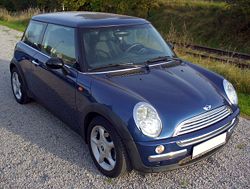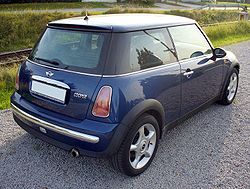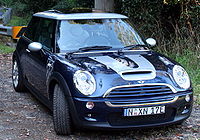- Mini Hatch (2001–2006)
-
Mini Hardtop/Hatch (2001–2006)
Production 2001–2006 Class Compact Body style 3-door hatchback Engine 1.4L Tritec I4 (One)
1.6L Tritec supercharged I4 (S)
1.4L Toyota 1ND-TV diesel (D)
1.6L Tritec I4 (One, Cooper)Transmission CVT
5-speed manual
6-speed automatic and manualWheelbase 97.1 in (2,470 mm) Length 2002–03 Base: 142.8 in (3,630 mm)
2004–06 Base: 143.1 in (3,630 mm)
S Hardtop: 143.9 in (3,660 mm)Width 66.5 in (1,690 mm) Height 2002–03 Base: 55.9 in (1,420 mm)
2002–03 S: 56.2 in (1,430 mm)
2004–06 Base: 55.4 in (1,410 mm)
2004–06 S: 55.8 in (1,420 mm)Kerb weight 2,496 lb (1,132 kg) The first new generation Mini was introduced in 2001. In many European markets, the Mini One was powered by a 1.4 litre I4[1] version of the Tritec engine but all other petrol powered Minis used the 1.6 litre I4 version.[2][3] Since 2005, a soft-top convertible option has been available across the entire range.
There are numerous styling and badging differences between the models, perhaps the most obvious being that the Cooper S has a distinctive scoop cut into the bonnet. The Cooper S also has twin exhausts which exit under the centre of the rear valance. The non-S Cooper has more chrome parts than the Mini One and has a single exhaust. The Mini One D has no visible exhaust pipes at all.
In some markets, such as Australia and the US, only the Mini Cooper and Cooper S are offered because the Mini One's engine was considered inadequate to deliver sufficient power to run an air conditioner — a necessary feature in those markets.[citation needed] Almost fifty percent of all Minis sold in Australia and about seventy percent of those sold in the U.S. are the more-powerful Cooper S model. Other models of note, sold in varying markets around the world, are the Mini Seven, Mini Park Lane, Mini Check Mate, and Mini Monte Carlo.
Contents
Development
The Mini Hatch (US: Hardtop) was designed by Frank Stephenson,[4] and drew inspiration from the original two-door Mini. The name of the new car's brand, MINI, was all-capitalised to distinguish it from its predecessor.[5] Development of the car was conducted between 1995 and 2001 by Rover Group in Gaydon, United Kingdom and BMW AG in Munich, Germany. During this development phase, there was continual contention between the two design groups, especially concerning the positioning of the car; Rover wanted a straight economy car, whilst BMW supported a small, sporting car. Ultimately, BMW prevailed, and in 1999, they assumed control over the entire project following the departure of BMW's CEO, Bernd Pischetsrieder.[6] When BMW divested itself of Rover in 2000, BMW elected to retain the Mini project, and to move the planned production site of the car from Rover's Longbridge plant,[6] to BMW's Oxford plant in Cowley, Oxford, United Kingdom. The team of designers working on the 2001 Mini had finished the full-sized clay mock-up of the Mini in plenty of time for a presentation to the board of directors. However, the chief designer, Frank Stephenson, realised that the model did not have an exhaust pipe.[4] His short-term solution was to pick up an empty beer can, punch a hole in it, strip off the paint and push it into the clay at the back of the car, which took just a few minutes.[4] The overall design for the mock-up was so good that the board members told him not to change a thing, resulting in the distinctive exhaust tip seen in production cars.[4][7]
Models
The vehicles produced during the 2001 to 2006 model years included four hatchback models (UK and some international markets: Hatch, US: Hardtop, other markets just plain Mini): the standard "Mini One", the diesel-engined "Mini One/D", the sportier "Mini Cooper" and the supercharged "Mini Cooper S"; in 2005, a convertible roof option was added to the Mk I line-up. In November 2006, BMW released a facelift version of the Mini Hardtop as a 2007 model-year vehicle.[8]
The names Cooper and Cooper S echo the names used for the sportier version of the classic Mini, which in turn come from the involvement of John Cooper and the Cooper Car Company. The Cooper heritage is further emphasised with the John Cooper Works (JCW) range of tuning options that are available with the Mini. John Cooper also created a one-off racing model of the Mini Cooper S named the Mini Cooper S Works. This car features many extras which help to improve performance, such as a racing exhaust and air filter as well as uprated suspension. The car also has one-of-a-kind 17-inch (430 mm) racing wheels.[9]
Specifications
The Mk I Mini One, Cooper and Cooper S used some version of the reliable, Brazilian-built Tritec engine, co-developed by Chrysler & BMW; the Mini One D used a Toyota-built diesel engine. In August 2006, BMW announced that future engines would be built in the UK, making the car essentially British-built again; final assembly took place at Oxford, and the body pressings were made in nearby Swindon at BMW's Swindon Pressings Ltd subsidiary.
All models used a transversely-mounted four-cylinder engine driving the front wheels. All four wheels are pushed to the corners of the body to improve handling. The styling of the car, like that of the Volkswagen's New Beetle, is a retro design that is deliberately reminiscent of the original Mini. The retro styling is further enhanced by retaining other classic Mini touches such as contrasting roof colours, optional bonnet stripes, optional rally lights, and black trim around the wheel arches and rocker panels that mimic the wide wheel flares found on many classic Minis.[4]
The Mini One and Mini Cooper were available with a ZF VT1F continuously variable transmission or with a conventional Midlands five-speed manual transmission (model years 2001–2004); the latter was replaced with a Getrag five-speed unit for the remainder of the Mk I production (2005–2006). The Cooper S came with a six-speed Getrag manual or (starting with the 2005 model year) a fully automatic transmission with paddle shifters.
As standard, the Mini had a drive by wire electronic throttle, anti-lock brake electronic brakeforce distribution, and BMW Cornering Brake Control. Stability options were BMW's ASC traction control system and DSC electronic stability control, to improve control and handling in adverse conditions.[9][10]
The addition of a supercharger to the Mk I Cooper S required that the battery be relocated into the rear of the car — leaving no room for a spare tyre; hence this model comes with run-flat tyres as standard.
See also
- Automotive industry in the United Kingdom
References
- ^ "Evo Magazine December 2007". Evo.co.uk. 2007-12-06. http://www.evo.co.uk/carreviews/evocarreviews/210841/mini_one.html. Retrieved 2011-06-25.
- ^ Martynn Randall. (2005). MINI Owners Workshop Manual July 2001 to 2005 (Y to 05 reg) Petrol. Sparkford: Haynes.
- ^ Mini Cooper: service manual, Mini Cooper, Mini Cooper S, 2002, 2003, 2004.. Cambridge, MA: BentleyPublishers.com. 2004. ISBN 0-8376-1068-0.
- ^ a b c d e Paterick C. Paternie. Mini. ISBN 0-7603-1157-9.
- ^ "BMW Operations and Production: Can you tell me more about the Mini?". BMW. http://www.bmweducation.co.uk/coFacts/view.asp?docID=17&topicID=3. Retrieved 2006-05-01.
- ^ a b "Anglo-German Success". The Unofficial Austin-Rover Web Resource. http://www.austin-rover.co.uk/r50storyf.htm. Retrieved 2007-01-29.
- ^ Roebuck, Bill. "2002 Mini Cooper Road Test: Mini Magic". Car Test. http://www.cartest.ca/2002_mini_cooper_.htm. Retrieved 9 July 2011. "He picked up an empty beer can, cut it in half, stripped off the paint, polished the metal, and glued it to the back of the car. It took just a few minutes."
- ^ "Introducing the 2007 Mini Cooper S". MC2 Magazine (Barry Brazier) (5). November 2006.
- ^ a b Gary Anderson; Don Racine (1982). Motoring: Getting the Maximum from Your New MINI. Los Altos, Calif.: Enthusiast Publications. ISBN 0-9765780-0-X.
- ^ Tim Mundy (2004). You & Your New MINI: Buying, Enjoying, Maintaining, Modifying. Somerset: Haynes. ISBN 1-84425-028-8.
Mini vehicle timeline 1959–present Model 1950s 1960s 1970s 1980s 1990s 2000s 2010s 9 0 1 2 3 4 5 6 7 8 9 0 1 2 3 4 5 6 7 8 9 0 1 2 3 4 5 6 7 8 9 0 1 2 3 4 5 6 7 8 9 0 1 2 3 4 5 6 7 8 9 0 1 2 3 4 5 6 7 8 9 Two-door hatch Mk I Mk II Mk III-Mk VII Hatch/Hardtop
(2001-2006)Hatch/Hardtop
(2007-)Cooper Mk I Cooper Mk II Cooper RSP Cooper Cooper
(2001-2006)Cooper
(2007-)Cooper S Mk I Cooper S Mk II Cooper S Mk III Cooper S ERA Cooper S
(2001-2006)Cooper S
(2007-)Innocenti Cooper Cooper 1300 Authi Mk II Cooper 1300 Clubman Clubman & 1275GT Moke Moke (UK) Moke (Australia) Moke (Portugal) Pickup Mini Pickup Mini 95 Van Mini Van Mini 95 Estate|Mini MPV Traveller & Countryman Clubman Cabrio Rover Cabrio Convertible
(2005-2008)Convertible
(2009-)Crossover Countryman Engines: A-Series engine · Tritec engine · Prince engine Categories:- Cars of England
- Mini vehicles
- Compact cars
- Front wheel drive vehicles
- Hatchbacks
- Retro style automobiles
- 2000s automobiles
- Vehicles introduced in 2001
Wikimedia Foundation. 2010.



